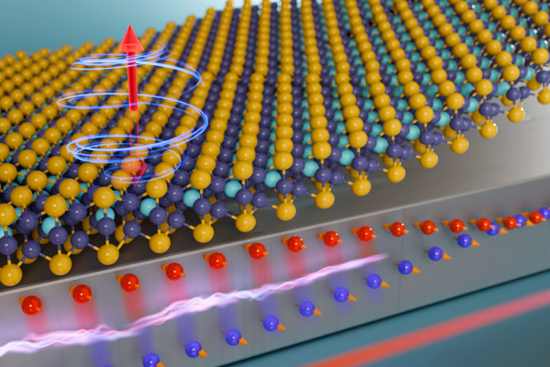MIT Researchers Harness 2D Magnetic Materials for Energy-Efficient Computing
Team precisely controlled ultra-thin magnet at room temperature, which could enable faster, more efficient processors and computer memories.
This is a Press Release edited by StorageNewsletter.com on February 29, 2024 at 2:01 pm
Experimental computer memories and processors built from magnetic materials use far less energy than traditional silicon-based devices. 2D magnetic materials, composed of layers that are only a few atoms thick, have incredible properties that could allow magnetic-based devices to achieve unprecedented speed, efficiency, and scalability.
This illustration shows electric current being pumped into platinum (the bottom slab), which results in the creation of an electron spin current that switches the magnetic state of the 2D ferromagnet on top. The colored spheres represent the atoms in the 2D material.
(Image: Courtesy of the researchers)
While many hurdles must be overcome until these so-called van der Waals magnetic materials can be integrated into functioning computers, MIT (Massachusetts Institute of Technology) researchers took an important step in this direction by demonstrating precise control of a van der Waals magnet at room temperature.
This is key, since magnets composed of atomically thin van der Waals materials can typically only be controlled at extremely cold temperatures, making them difficult to deploy outside a laboratory.
The researchers used pulses of electrical current to switch the direction of the device’s magnetization at room temperature. Magnetic switching can be used in computation, the same way a transistor switches between open and closed to represent 0s and 1s in binary code, or in computer memory, where switching enables data storage.
The team fired bursts of electrons at a magnet made of a new material that can sustain its magnetism at higher temperatures. The experiment leveraged a fundamental property of electrons known as spin, which makes the electrons behave like tiny magnets. By manipulating the spin of electrons that strike the device, the researchers can switch its magnetization.
“The heterostructure device we have developed requires an order of magnitude lower electrical current to switch the van der Waals magnet, compared to that required for bulk magnetic devices,” says Deblina Sarkar, AT&T career development assistant professor, MIT Media Lab and Center for Neurobiological Engineering, head, Nano-Cybernetic Biotrek Lab, and the senior author of a paper on this technique. “Our device is also more energy efficient than other van der Waals magnets that are unable to switch at room temperature.”
In the future, such a magnet could be used to build faster computers that consume less electricity. It could also enable magnetic computer memories that are nonvolatile, which means they don’t leak information when powered off, or processors that make complex AI algorithms more energy-efficient.
“There is a lot of inertia around trying to improve materials that worked well in the past. But we have shown that if you make radical changes, starting by rethinking the materials you are using, you can potentially get much better solutions,” says Shivam Kajale, graduate student, Sarkar’s lab and co-lead author of the paper.
Kajale and Sarkar are joined on the paper by co-lead author Thanh Nguyen, graduate student, Department of Nuclear Science and Engineering (NSE); Corson Chao, graduate student, Department of Materials Science and Engineering (DSME); David Bono, DSME research scientist; Artittaya Boonkird, NSE graduate student; and Mingda Li, associate professor, nuclear science and engineering. The research appears in Nature Communications.
An atomically thin advantage
Methods to fabricate tiny computer chips in a clean room from bulk materials like silicon can hamper devices. For instance, the layers of material may be barely 1 nanometer thick, so minuscule rough spots on the surface can be severe enough to degrade performance.
By contrast, van der Waals magnetic materials are intrinsically layered and structured in such a way that the surface remains perfectly smooth, even as researchers peel off layers to make thinner devices. In addition, atoms in one layer won’t leak into other layers, enabling the materials to retain their unique properties when stacked in devices.
“In terms of scaling and making these magnetic devices competitive for commercial applications, van der Waals materials are the way to go,” Kajale says.
But there’s a catch. This new class of magnetic materials have typically only been operated at temperatures below 60 kelvins (-351°F). To build a magnetic computer processor or memory, researchers need to use electrical current to operate the magnet at room temperature.
To achieve this, the team focused on an emerging material called iron gallium telluride. This atomically thin material has all the properties needed for effective room temperature magnetism and doesn’t contain rare earth elements, which are undesirable because extracting them is especially destructive to the environment.
Nguyen carefully grew bulk crystals of this 2D material using a special technique. Then, Kajale fabricated a 2-layer magnetic device using nanoscale flakes of iron gallium telluride underneath a 6-nanometer layer of platinum.
Tiny device in hand, they used an intrinsic property of electrons known as spin to switch its magnetization at room temperature.
Electron ping-pong
While electrons don’t technically ‘spin’ like a top, they do possess the same kind of angular momentum. That spin has a direction, either up or down. The researchers can leverage a property known as spin-orbit coupling to control the spins of electrons they fire at the magnet.
The same way momentum is transferred when one ball hits another, electrons will transfer their ‘spin momentum’ to the 2D magnetic material when they strike it. Depending on the direction of their spins, that momentum transfer can reverse the magnetization.
In a sense, this transfer rotates the magnetization from up to down (or vice-versa), so it is called a ‘torque,’ as in spin-orbit torque switching. Applying a negative electric pulse causes the magnetization to go downward, while a positive pulse causes it to go upward.
The researchers can do this switching at room temperature for 2 reasons: the special properties of iron gallium telluride and the fact that their technique uses small amounts of electrical current. Pumping too much current into the device would cause it to overheat and demagnetize.
The team faced many challenges over the 2 years it took to achieve this milestone, Kajale says. Finding the right magnetic material was only half the battle. Since iron gallium telluride oxidizes quickly, fabrication must be done inside a glovebox filled with nitrogen.
“The device is only exposed to air for 10 or 15s, but even after that I have to do a step where I polish it to remove any oxide,” he says.
Now that they have demonstrated room-temperature switching and greater energy efficiency, the researchers plan to keep pushing the performance of magnetic van der Waals materials.
“Our next milestone is to achieve switching without the need for any external magnetic fields. Our aim is to enhance our technology and scale up to bring the versatility of van der Waals magnet to commercial applications,” Sarkar says.
This work was carried out, in part, using the facilities at MIT.Nano and the Harvard University Center for Nanoscale Systems.
Resource:
Video: Electrical switching of atomically layered magnets at room temperature
Article: Current-induced switching of a van der Waals ferromagnet at room temperature
Nature Communications has published an article written by Shivam N. Kajale, MIT Media Lab, Massachusetts Institute of Technology, Cambridge, MA, USA , Thanh Nguyen, Department of Nuclear Science and Engineering, Massachusetts Institute of Technology, Cambridge, MA, USA , Corson A. Chao, Department of Materials Science and Engineering, Massachusetts Institute of Technology, Cambridge, MA, USA, David C. Bono, Department of Materials Science and Engineering, Massachusetts Institute of Technology, Cambridge, MA, USA , Artittaya Boonkird, Department of Nuclear Science and Engineering, Massachusetts Institute of Technology, Cambridge, MA, USA , Mingda Li, Department of Nuclear Science and Engineering, Massachusetts Institute of Technology, Cambridge, MA, USA , and Deblina Sarkar, MIT Media Lab, Massachusetts Institute of Technology, Cambridge, MA, USA.
Abstract: “Recent discovery of emergent magnetism in van der Waals magnetic materials (vdWMM) has broadened the material space for developing spintronic devices for energy-efficient computation. While there has been appreciable progress in vdWMM discovery, a solution for non-volatile, deterministic switching of vdWMMs at room temperature has been missing, limiting the prospects of their adoption into commercial spintronic devices. Here, we report the first demonstration of current-controlled non-volatile, deterministic magnetization switching in a vdW magnetic material at room temperature. We have achieved spin-orbit torque (SOT) switching of the PMA vdW ferromagnet Fe3GaTe2 using a Pt spin-Hall layer up to 320 K, with a threshold switching current density as low as \({J}_{{{{{{\rm{sw}}}}}}}=\)1.69 \(\times\) 106 A cm−2 at room temperature. We have also quantitatively estimated the anti-damping-like SOT efficiency of our Fe3GaTe2/Pt bilayer system to be \({\xi }_{{{{{{\rm{DL}}}}}}}=0.093\), using the second harmonic Hall voltage measurement technique. These results mark a crucial step in making vdW magnetic materials a viable choice for the development of scalable, energy-efficient spintronic devices.“

















 Subscribe to our free daily newsletter
Subscribe to our free daily newsletter

